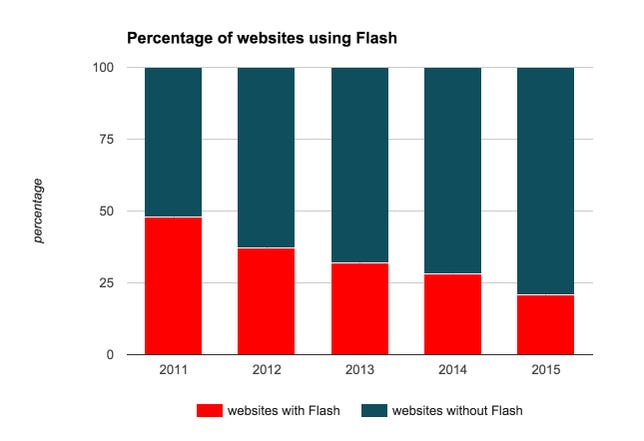You could be forgiven for thinking Adobe Systems just killed Flash, the software that for years delivered video, ads and games to Web browsers.
On Monday, the company renamed its Flash Professional developer tools Animate, making a once-powerful brand name a historical footnote. Journalists weighed in with lines like “RIP Flash,” “Adobe is finally ready to say goodbye to Flash” and “Adobe Flash is finally dead.”
The reality is less dramatic.
It would be more metaphorically accurate to say Adobe just hammered the 20th nail into Flash’s coffin, but it’ll take another 10 or so before we can really call it dead. This is just the latest development in a years-long shift to build Flash capabilities, like animated graphics, premium video and refined typography, directly into Web browsers.
There are lots of good reasons to get rid of Flash. Browser makers say it’s a top sore spot for security, performance and shorter battery life. No matter how eager you may be, though, transitions away from technology as widely used as Flash take years to achieve.
Mainframes, which took the computing world by storm five decades ago, are still with us. The 15-pin VGA connector dating back to 1987 remains widely used to plug projectors into laptops. Smartphones are great, but there are sure a lot of PCs around in the post-PC era.
Computing revolutions can move fast, but the old guard hangs around for an awfully long time.
“There are hundreds of thousands of developers and designers that continue to use Flash, which means the technology will be there for some time,” said IDC analyst Al Hilwa. “That HTML5 is not yet up to every capability of Flash is clearly a factor.”
Adobe fought and lost
Flash became popular in the late 1990s for good reason. It injected interactivity and polished design into the Web. Over the last decade, though, browser makers and programmers have worked hard to improve the core Web technologies of HTML, CSS and JavaScript and to wean the Web from Flash reliance.
Adobe fought hard for Flash but lost. In 2009, Adobe pledged to bring Flash Player to smartphones. It found a place on Android phones in 2010, but Apple Chief Executive Steve Jobs banished Flash from iPhones, demolishing any hopes Flash developers had of seeing their creations on the influential hardware.
In November 2011, Adobe hammered the first nail into Flash’s coffin: the cancellation of Flash Player for mobile devices and the shift of engineering staff to Web standards like HTML5.
There have been plenty of nails since. Microsoft, Mozilla and Google started cutting off browser plug-in technology, telegraphing that Flash’s approach to extending browser abilities was doomed even if the browsers themselves carved out an exception for Flash.

 Enlarge Image
Enlarge ImageFlash is in decline but still used on about a fifth of the hundreds of thousands of websites the HTTP Archive service monitors.
Stephen Shankland/CNET
Google’s YouTube started showing video using HTML5 technology by default this year. Microsoft, Netflix and Google added copy-protection technology so Web video didn’t need Flash for digital rights management, a move Adobe has supported.
With an eye toward the future, Mozilla’s Shumway software can run some Flash content without relying on Flash itself, so that old Web pages won’t break.
In July, Facebook Chief Security Officer Alex Stamos called for a deadline for Flash’s extermination. Adobe hasn’t set one, but on Monday, the company said it’s working with Facebook to improve Flash security.
Work to be done
There’s still work to do before Flash retires.
Though Flash has steadily declined in usage, the technology is still common. On the 482,000 websites the HTTP Archive monitors, 21 percent still use Flash as of mid-November.
It would be easy for Mozilla to remove Flash support from Firefox, but users still want it, Mark Mayo, Mozilla’s senior vice president of Firefox, said in an October interview. “It feels a bit academic to say take it out,” he said, expressing a preference for a gradual phase-out. “We’re on a path of responsible disarmament that slowly but surely reduces the number of Flash activations.”
Mat Groves, the co-founder of programming firm Good Boy Digital who’s worked on advanced Web graphics tools, still sees shortcomings in the developer tools built around Web standards. Flash Pro could help: the transition to Animate “is a really great move from Adobe,” he said. “Repositioning Flash as a platform-agnostic animation tool is the perfect thing to do.”
Craig Morrison, a designer and Web developer from Glasgow, Scotland, agrees on the need for better creative tools for Web developers. That’s good news for Adobe’s business prospects.
The Flash Professional brand name is being retired, but the tool itself will live on as Animate. Adobe has been expanding its abilities to produce HTML content instead of Flash content, and increasingly that’s its main job, Rich Lee, an Adobe senior product marketing manager, said in a Monday blog post.
“Today, over a third of all content created in Flash Professional uses HTML5,” he said.




